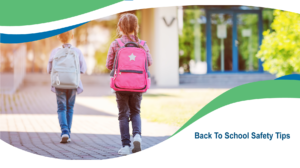Back To School Safety Tips
Start thinking about these safety tips because back to school is just around the corner and safety is on top of everyone’s mind including parents, teachers, administrators, and of course students.
Parents should have a sit-down talk with their children that emphasizes the importance of safety when they return to school. This should include everything from communication, traveling to and from school as well as staying healthy and secure at school.
1. Emphasize the importance of safety as children return to school.
The Washington Post has identified 203 children and educators who have died and 453 who were injured between the Columbine shooting in 2019 and today, with the scourge of school violence showing no signs of decline. There have been 404 school shootings since 1999, according to Post data.
The most important thing you can do is listen to your child if they express any anxiety or fear of school violence, encourage discussion and respond with information you have appropriate for their age, and don’t over-explain. Seek professional help for any serious fears your child has about returning to school.
2. Make travel safe for commuting, whether walking, biking, or taking the bus.
Children who walk or bike to school should follow Safe Routes to School (SRTS)–an international movement–and federal program–that uses programs and infrastructure to encourage children to walk and bike to school. SRTS is adopted by many school districts across the country.
It’s very important for kids to look both ways before crossing any street and follow all traffic signals and signs. Parents should practice with their children how, where and when to wait for the bus or public transportation including bus times and information, as well as how to stay safe on the bus by wearing a seat belt and taking other safety precautions. It’s best to cross in front of a bus if necessary so the driver can see them, but children should never run in front of any bus unless they are given instructions that it’s ok to do so.
3. Keep kids healthy with reminders about hygiene, masks, and staying home when sick.
Remind your children to wash their hands at school and home as much as possible because it’s a very good way to keep germs at bay. An N95 mask is also a good way to keep children with immune disorders safer from airborne illnesses as is staying home if sick.
4. Ensure a safe physical space within the school premises.
The percentage of traditional public schools without a panic button or silent alarm system in 2022 was 43 percent, according to an Institution of Education Sciences report. Additionally, legislators started to act after the shooting at Marjory Stoneman Douglas School in Florida in 2018 that killed 17 people. Parents of one of the students killed started the Make Our Schools Safe Foundation which helped pass the first Alyssa’s Law in New Jersey in 2019, mandating the installation of emergency alert systems that connect to law enforcement in public schools. Five states have also passed Alyssa’s Law since New Jersey in 2019, with many states pending.
The RFT Help Alert system is a comprehensive solution that is fully compliant with Alyssa’s Law and includes a silent emergency panic button that automatically connects to law enforcement and 911, and LoRa (Long Range), wireless indoor and outdoor coverage. This system allows staff to instantly alert security personnel in case of emergencies and fills the need for schools with or without security resource officers to respond to incidents. It’s imperative that parents know what their school districts are doing to keep their children safe and lobby them to install the most comprehensive security systems they can afford. There are many grants for U.S. schools who need access to funding for school panic alarm crisis systems which you can find out about in RFT’s How To Apply for School Panic Alarm System Grants in the U.S.
Conclusion:
Encourage ongoing communication between parents, children, and schools for a safe school year. Emphasize safety, how to travel, stay healthy, and make sure your school or district has a comprehensive school panic alarm system in place.




